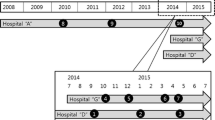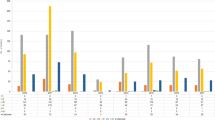Abstract
The genetic distribution of invasive methicillin-susceptible (MSSA) and resistant S. aureus (MRSA) strains has to be addressed in order to target infection control strategies. A large MRSA epidemic caused by a certain MRSA strain (spa type 067) broke out in 2001 in our health district. We wanted to investigate the current spa type distribution in MRSA and MSSA bacteremias and assess the potential association of spa clonal complexes (spaCC) with the clinical characteristics of S. aureus bacteremia. One hundred nine invasive MRSA isolates and 353 invasive MSSA isolates were spa typed and grouped into clonal complexes (spaCC). Spa type distribution was compared to that of colonizing MRSA strains. Spa type and spaCC data linked to clinical information on the course of bacteremic cases was used to search for differences in virulence between strains. Spa type distribution in MRSA is less heterogenic than in MSSA. t067 dominates both in MRSA colonisations and in invasive findings. Among MSSA, no such dominating strains were found. Of spaCCs, mortality was the highest in spaCC 067 (25.6%). SpaCC 008 was more often associated with endocarditis than other CCs (22.7 vs 5.8%, p = 0.013), spaCC 2133 with skin infections (68.4 vs 36.4%, p = 0.007), and spaCC 012 with foreign body infections (25.0 vs 9.3%, p = 0.029) than other clonal complexes. A single successful strain can explain the major proportion of MRSA among S. aureus bacteremias. Certain spaCCs showed association with certain clinical characteristics. These findings suggest that S. aureus strains differ in their virulence and invasiveness.
Similar content being viewed by others
References
Young BC, Golubchik T, Batty EM, Fung R, Larner-Svensson H, Votintseva AA, Miller RR, Godwin H, Knox K, Everitt RG, Iqbal Z, Rimmer AJ, Cule M, Ip CL, Didelot X, Harding RM, Donnelly P, Peto TE, Crook DW, Bowden R, Wilson DJ (2012) Evolutionary dynamics of Staphylococcus aureus during progression from carriage to disease. Proc Natl Acad Sci U S A 109:4550–4555
van Hal SJ, Jensen SO, Vaska VL, Espedido BA, Paterson DL, Gosbell IB (2012) Predictors of mortality in Staphylococcus aureus bacteremia. Clin Microbiol Rev 25:362–386
Cosgrove SE, Sakoulas G, Perencevich EN, Schwaber MJ, Karchmer AW, Carmeli Y (2003) Comparison of mortality associated with methicillin-resistant and methicillin-susceptible Staphylococcus aureus bacteremia: a meta-analysis. Clin Infect Dis 36:53–59
Rasmussen G, Monecke S, Ehricht R, Soderquist B (2013) Prevalence of clonal complexes and virulence genes among commensal and invasive Staphylococcus aureus isolates in Sweden. PLoS One 8:e77477
Lowy FD (1998) Staphylococcus aureus infections. N Engl J Med 339:520–532
Holtfreter S, Grumann D, Balau V, Barwich A, Kolata J, Goehler A, Weiss S, Holtfreter B, Bauerfeind SS, Doring P, Friebe E, Haasler N, Henselin K, Kuhn K, Nowotny S, Radke D, Schulz K, Schulz SR, Trube P, Vu CH, Walther B, Westphal S, Cuny C, Witte W, Volzke H, Grabe HJ, Kocher T, Steinmetz I, Broker BM (2016) Molecular epidemiology of Staphylococcus aureus in the general population in Northeast Germany: results of the Study of Health in Pomerania (SHIP-TREND-0). J Clin Microbiol 54:2774–2785
Blomfeldt A, Aamot HV, Eskesen AN, Monecke S, White RA, Leegaard TM, Bjornholt JV (2016) DNA microarray analysis of Staphylococcus aureus causing bloodstream infection: bacterial genes associated with mortality? Eur J Clin Microbiol Infect Dis 35:1285–1295
Edgeworth JD, Yadegarfar G, Pathak S, Batra R, Cockfield JD, Wyncoll D, Beale R, Lindsay JA (2007) An outbreak in an intensive care unit of a strain of methicillin-resistant Staphylococcus aureus sequence type 239 associated with an increased rate of vascular access device-related bacteremia. Clin Infect Dis 44:493–501
Lindsay JA, Moore CE, Day NP, Peacock SJ, Witney AA, Stabler RA, Husain SE, Butcher PD, Hinds J (2006) Microarrays reveal that each of the ten dominant lineages of Staphylococcus aureus has a unique combination of surface-associated and regulatory genes. J Bacteriol 188:669–676
Bouchiat C, Moreau K, Devillard S, Rasigade JP, Mosnier A, Geissmann T, Bes M, Tristan A, Lina G, Laurent F, Piroth L, Aissa N, Duval X, Le Moing V, Vandenesch F, French VIRSTA Study Group (2015) Staphylococcus aureus infective endocarditis versus bacteremia strains: subtle genetic differences at stake. Infect Genet Evol 36:524–530
Blomfeldt A, Eskesen AN, Aamot HV, Leegaard TM, Bjornholt JV (2016) Population-based epidemiology of Staphylococcus aureus bloodstream infection: clonal complex 30 genotype is associated with mortality. Eur J Clin Microbiol Infect Dis 35:803–813
Grundmann H, Aanensen DM, van den Wijngaard CC, Spratt BG, Harmsen D, Friedrich AW, European Staphylococcal Reference Laboratory Working Group (2010) Geographic distribution of Staphylococcus aureus causing invasive infections in Europe: a molecular-epidemiological analysis. PLoS Med 7:e1000215
Grundmann H, Schouls LM, Aanensen DM, Pluister GN, Tami A, Chlebowicz M, Glasner C, Sabat AJ, Weist K, Heuer O, Friedrich AW, ESCMID Study Group on Molecular Epidemiological Markers, European Staphylococcal Reference Laboratory Working Group (2014) The dynamic changes of dominant clones of Staphylococcus aureus causing bloodstream infections in the European region: results of a second structured survey. Euro Surveill 19:20987
Falugi F, Kim HK, Missiakas DM, Schneewind O (2013) Role of protein A in the evasion of host adaptive immune responses by Staphylococcus aureus. MBio 4:e00575–e00513
Hong X, Qin J, Li T, Dai Y, Wang Y, Liu Q, He L, Lu H, Gao Q, Lin Y, Li M (2016) Staphylococcal protein a promotes colonization and immune evasion of the epidemic healthcare-associated MRSA ST239. Front Microbiol 7:951
Nguyen T, Ghebrehiwet B, Peerschke EI (2000) Staphylococcus aureus protein A recognizes platelet gC1qR/p33: a novel mechanism for staphylococcal interactions with platelets. Infect Immun 68:2061–2068
Aamot HV, Blomfeldt A, Eskesen AN (2012) Genotyping of 353 Staphylococcus aureus bloodstream isolates collected between 2004 and 2009 at a Norwegian university hospital and potential associations with clinical parameters. J Clin Microbiol 50:3111–3114
Fowler VG Jr, Nelson CL, McIntyre LM, Kreiswirth BN, Monk A, Archer GL, Federspiel J, Naidich S, Remortel B, Rude T, Brown P, Reller LB, Corey GR, Gill SR (2007) Potential associations between hematogenous complications and bacterial genotype in Staphylococcus aureus infection. J Infect Dis 196:738–747
Jogenfors A, Stark L, Svefors J, Lofgren S, Malmvall BE, Matussek A (2014) A recommendation to perform a blood culture before the administration of intravenous antibiotics increased the detection of Staphylococcus aureus bacteremia. Eur J Clin Microbiol Infect Dis 33:789–795
Enright MC, Robinson DA, Randle G, Feil EJ, Grundmann H, Spratt BG (2002) The evolutionary history of methicillin-resistant Staphylococcus aureus (MRSA). Proc Natl Acad Sci U S A 99:7687–7692
Rolo J, Miragaia M, Turlej-Rogacka A, Empel J, Bouchami O, Faria NA, Tavares A, Hryniewicz W, Fluit AC, de Lencastre H, CONCORD Working Group (2012) High genetic diversity among community-associated Staphylococcus aureus in Europe: results from a multicenter study. PLoS One 7:e34768
Kinnevey PM, Shore AC, Brennan GI, Sullivan DJ, Ehricht R, Monecke S, Coleman DC (2014) Extensive genetic diversity identified among sporadic methicillin-resistant Staphylococcus aureus isolates recovered in Irish hospitals between 2000 and 2012. Antimicrob Agents Chemother 58:1907–1917
Zarfel G, Luxner J, Folli B, Leitner E, Feierl G, Kittinger C, Grisold A (2016) Increase of genetic diversity and clonal replacement of epidemic methicillin-resistant Staphylococcus aureus strains in South-East Austria. FEMS Microbiol Lett 363: https://doi.org/10.1093/femsle/fnw137
Jokinen E, Laine J, Huttunen R, Rahikka P, Huhtala H, Vuento R, Vuopio J, Syrjanen J (2017) Comparison of outcome and clinical characteristics of bacteremia caused by methicillin-resistant, penicillin-resistant and penicillin-susceptible Staphylococcus aureus strains. Infect Dis (Lond):1–8
Jokinen E, Laine J, Huttunen R, Arvola P, Vuopio J, Lindholm L, Vuento R, Syrjanen J (2015) Combined interventions are effective in MRSA control. Infect Dis (Lond) 47:801–807
Laine J, Huttunen R, Vuento R, Arvola P, Levola R, Vuorihuhta M, Syrjanen J, Vuopio J, Lumio J (2013) Methicillin-resistant Staphylococcus aureus epidemic restricted to one health district in Finland: a population-based descriptive study in Pirkanmaa, Finland, years 2001-2011. Scand J Infect Dis 45:45–53
Mellmann A, Weniger T, Berssenbrugge C, Rothganger J, Sammeth M, Stoye J, Harmsen D (2007) Based Upon Repeat Pattern (BURP): an algorithm to characterize the long-term evolution of Staphylococcus aureus populations based on spa polymorphisms. BMC Microbiol 7:98
Ruppitsch W, Indra A, Stoger A, Mayer B, Stadlbauer S, Wewalka G, Allerberger F (2006) Classifying spa types in complexes improves interpretation of typing results for methicillin-resistant Staphylococcus aureus. J Clin Microbiol 44:2442–2448
Li JS, Sexton DJ, Mick N, Nettles R, Fowler VG Jr, Ryan T, Bashore T, Corey GR (2000) Proposed modifications to the Duke criteria for the diagnosis of infective endocarditis. Clin Infect Dis 30:633–638
Moran GJ, Krishnadasan A, Gorwitz RJ, Fosheim GE, Mcdougal LK, Carey RB, Talan DA, EMERGEncy ID Net Study Group (2006) Methicillin-resistant S. aureus infections among patients in the emergency department. N Engl J Med 355:666–674
Boundy S, Zhao Q, Fairbanks C, Folgosa L, Climo M, Archer GL (2012) Spontaneous staphylococcal cassette chromosome mec element excision in Staphylococcus Aureus nasal carriers. J Clin Microbiol 50:469–471
Likitalo O, Lyytikäinen O, Lindholm L, Syrjänen J, Rintala E, Rantanen M, Vuopio J (2016) MRSA:n epidemiologia jatkuvassa muutoksessa (in Finnish). Suomen Lääkärilehti 47:3009–3015
Talan DA, Krishnadasan A, Gorwitz RJ, Fosheim GE, Limbago B, Albrecht V, Moran GJ, EMERGEncy ID Net Study Group (2011) Comparison of Staphylococcus aureus from skin and soft-tissue infections in US emergency department patients, 2004 and 2008. Clin Infect Dis 53:144–149
Gonzalez-Dominguez M, Seral C, Potel C, Constenla L, Algarate S, Gude MJ, Alvarez M, Castillo FJ (2015) Antimicrobial resistance, virulence factors and genetic lineages of hospital-onset methicillin-resistant Staphylococcus aureus isolates detected in a hospital in Zaragoza. Enferm Infecc Microbiol Clin 33:590–596
Jokinen E, Laine J, Huttunen R, Lyytikainen O, Vuento R, Vuopio J, Syrjanen J (2018) Trends in incidence and resistance patterns of Staphylococcus aureus bacteremia(). Infect Dis (Lond) 50:52–58
Tristan A, Rasigade JP, Ruizendaal E, Laurent F, Bes M, Meugnier H, Lina G, Etienne J, Celard M, Tattevin P, Monecke S, Le Moing V, Vandenesch F, French AEPEI study Group on Infective Endocarditis (2012) Rise of CC398 lineage of Staphylococcus aureus among infective endocarditis isolates revealed by two consecutive population-based studies in France. PLoS One 7:e51172
Nethercott C, Mabbett AN, Totsika M, Peters P, Ortiz JC, Nimmo GR, Coombs GW, Walker MJ, Schembri MA (2013) Molecular characterization of endocarditis-associated Staphylococcus aureus. J Clin Microbiol 51:2131–2138
Nienaber JJ, Sharma Kuinkel BK, Clarke-Pearson M, Lamlertthon S, Park L, Rude TH, Barriere S, Woods CW, Chu VH, Marin M, Bukovski S, Garcia P, Corey GR, Korman T, Doco-Lecompte T, Murdoch DR, Reller LB, Fowler VG Jr, International Collaboration on Endocarditis-Microbiology Investigators (2011) Methicillin-susceptible Staphylococcus aureus endocarditis isolates are associated with clonal complex 30 genotype and a distinct repertoire of enterotoxins and adhesins. J Infect Dis 204:704–713
Harris SR, Feil EJ, Holden MT, Quail MA, Nickerson EK, Chantratita N, Gardete S, Tavares A, Day N, Lindsay JA, Edgeworth JD, de Lencastre H, Parkhill J, Peacock SJ, Bentley SD (2010) Evolution of MRSA during hospital transmission and intercontinental spread. Science 327:469–474
Hodille E, Rose W, Diep BA, Goutelle S, Lina G, Dumitrescu O (2017) The role of antibiotics in modulating virulence in Staphylococcus aureus. Clin Microbiol Rev 30:887–917
Otto MP, Martin E, Badiou C, Lebrun S, Bes M, Vandenesch F, Etienne J, Lina G, Dumitrescu O (2013) Effects of subinhibitory concentrations of antibiotics on virulence factor expression by community-acquired methicillin-resistant Staphylococcus aureus. J Antimicrob Chemother 68:1524–1532
Funding
This study was financially supported by the Competitive State Research Financing of the Expert Responsibility Area of Tampere University Hospital.
Author information
Authors and Affiliations
Corresponding author
Ethics declarations
Conflict of interest
The authors declare that they have no conflict of interest.
Informed consent
Informed consent was not required because this was a retrospective study design based only on the review of hospital patient record data.
Ethical approval
The study was approved by the Ethical Review board of the Pirkanmaa Health District (R12254).
Additional information
This work was carried out at Tampere University Hospital and at School of Medicine, University of Tampere, Finland.
Rights and permissions
About this article
Cite this article
Jokinen, E., Lindholm, L., Huttunen, R. et al. Spa type distribution in MRSA and MSSA bacteremias and association of spa clonal complexes with the clinical characteristics of bacteremia. Eur J Clin Microbiol Infect Dis 37, 937–943 (2018). https://doi.org/10.1007/s10096-018-3210-1
Received:
Accepted:
Published:
Issue Date:
DOI: https://doi.org/10.1007/s10096-018-3210-1




